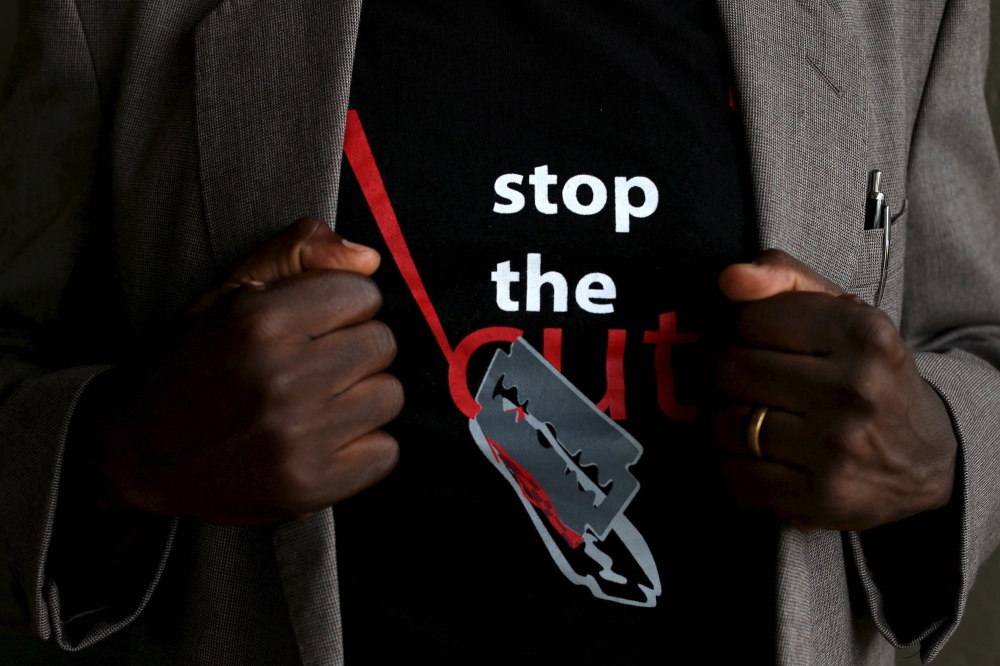London
Thomson Reuters Foundation
Female genital mutilation will take centuries to eradicate despite world leaders promising to end the practice by 2030, according to United Nations data released on Thursday.
FGM remains as common today as 30 years ago in Somalia, Mali, Gambia, Guinea Bissau, Chad and Senegal, the UN children’s agency UNICEF said, while countries making progress need to change at least 10 times faster to meet the 2030 goal.

A man shows the logo of a T-shirt that reads “Stop the Cut” referring to Female Genital Mutilation during a social event advocating against harmful practices such as FGM at the Imbirikani Girls High School in Imbirikani, Kenya, on 21st April, 2016. PICTURE: ReutersSiegfried Modola
“Some countries are not moving at all and those that are moving are not moving fast enough,” UNICEF analyst Claudia Cappa told the Thomson Reuters Foundation.
A “CRIPPLING” ECONOMIC TOLL
Female genital mutilation is exacting a “crippling” economic toll on many countries, the United Nations said on Thursday as it launched a tool to help them calculate the cost of treating girls and women harmed by the practice.
With an estimated 200 million girls and women worldwide have undergone FGM – which causes a host of mental and physical health problems including hemorrhaging, chronic infections, cysts and life-threatening childbirth complications – the World Health Organization calculated it would cost $US1.4 billion a year to treat all resulting medical needs.
“FGM is not only a catastrophic abuse of human rights that significantly harms…millions of girls and women, it is also a drain on a country’s vital economic resources,” said Ian Askew, WHO’s head of sexual and reproductive health.
The new calculator tool, launched on International Day of Zero Tolerance for FGM, covers 27 countries, mostly in Africa.
The cost in Egypt would be about $US876,825,000 and Sudan $US274,765,000. In some countries the costs would amount to 30 per cent of their yearly health expenditure, demonstrating the clear economic benefits of ending FGM, WHO said.
But global anti-FGM charity 28 Too Many said the health costs were a “drop in the ocean” compared to the wider costs for society and the economy.
“Girls who undergo FGM are often married off young, limiting their education and prospects,” executive director Ann-Marie Wilson told the Thomson Reuters Foundation.
“This entrenches poverty in communities and seriously holds back countries’ economic development.”
WHO estimated that the health cost of FGM would soar by 50 per cent by 2050 if no action is taken, as populations grow and more girls are cut.
– EMMA BATHA, Thomson Reuters Foundation
“It will take centuries if they continue at the same rate.”
Estimated to affect at least 200 million girls and women globally, FGM causes multiple mental and physical health problems. A 12-year-old girl recently died in Egypt after undergoing FGM.
FGM typically involves the partial or total removal of the external genitalia. Sometimes the vaginal opening is sewn up.
The practice is most closely linked to 30 predominantly African countries, but UNICEF said it may be practiced in about 50 countries including in Asia, the Middle East, Latin America and Eastern Europe.
Although no high prevalence country is on track to meet the 2030 goal, Cappa said attitudes were changing in many places.
In countries affected by FGM, seven in 10 women think the practice should end, and half of women who have themselves been cut would like to see it stop, according to the report published on International Day of Zero Tolerance for FGM.
The most dramatic decline in recent decades has been in the Maldives, a chain of islands in the Indian Ocean, where FGM used to affect nearly 40 per cent of girls and women, but has now been virtually eradicated.
UNICEF also voiced concern about increased “medicalisation” of FGM hampering global efforts to end the practice.
About a quarter of girls and women who have undergone FGM were cut by a doctor, midwife or other health worker as opposed to a traditional circumciser, UNICEF said.
“Doctor-sanctioned mutilation is still mutilation. Trained health-care professionals who perform FGM violate girls’ fundamental rights, physical integrity and health,” executive director Henrietta Fore said.
“Medicalising the practice does not make it safe, moral, or defensible.”





